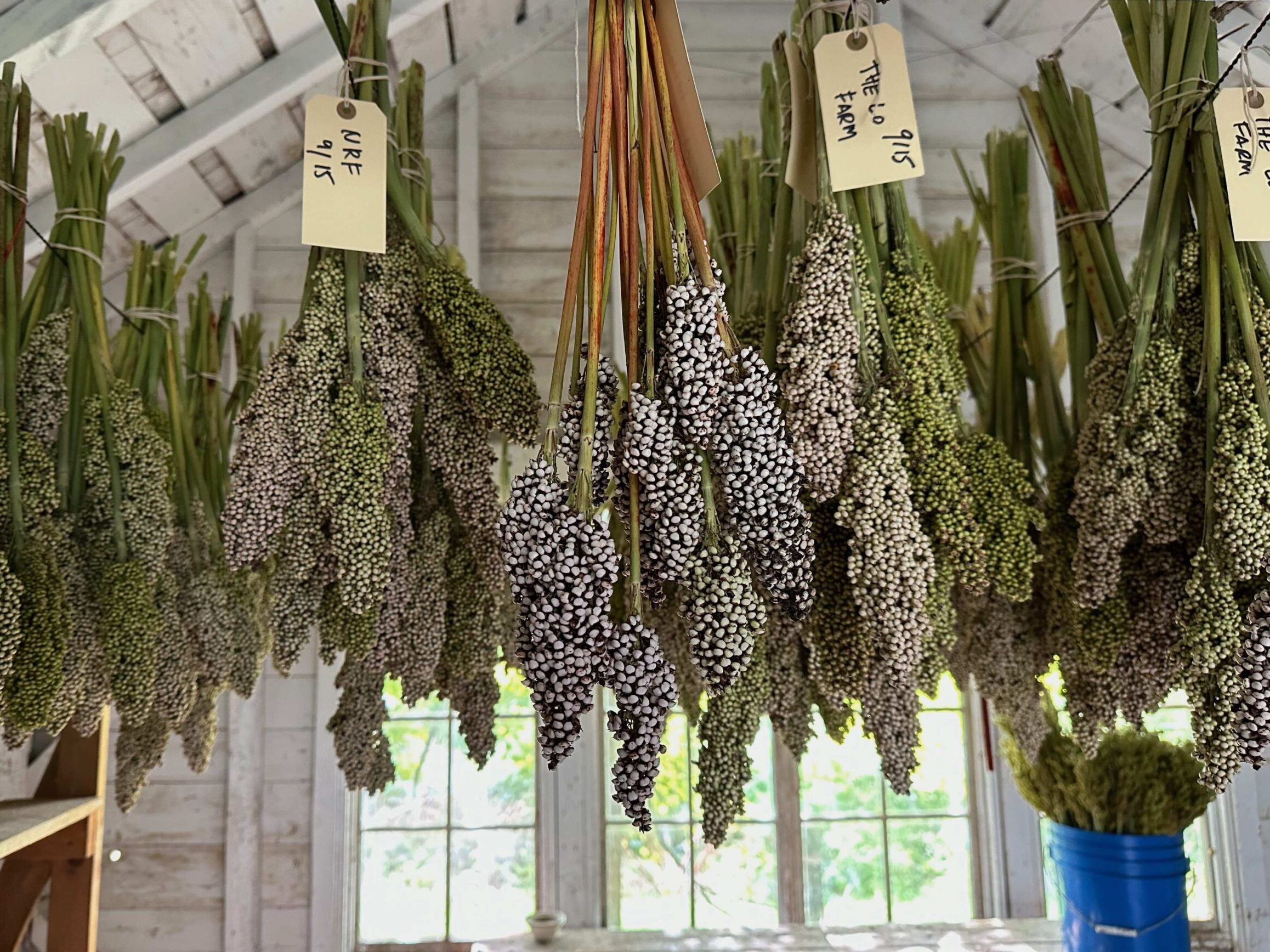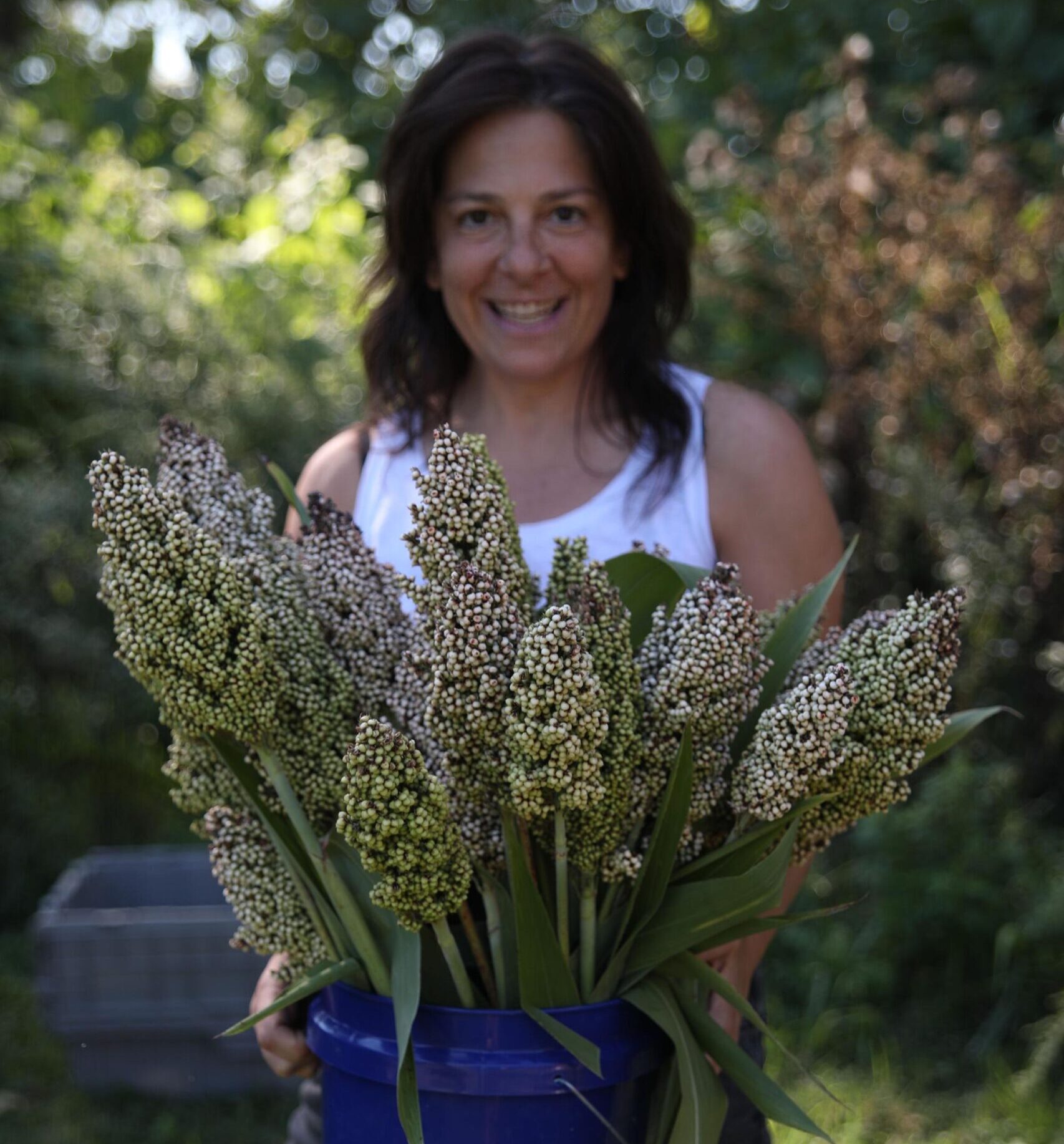The soil-obsessed artist bringing sorghum to New York farms
An artist who fell in love with a climate-resilient crop is pushing for a slow revolution
Carrie Klein • October 21, 2024

The U.S. is the world’s largest producer of sorghum, but almost all of it is exported for livestock feed or biofuel. Brooke Singer, pictured above holding a bucket of sorghum, is trying to change that. [Credit: Brooke Singer]
Brooke Singer is obsessed with soil. More than that, she’s obsessed with sorghum: a plant with little white pods that can quickly grow 13 feet tall in both drought and flood-prone environments. In her Brooklyn home studio, bunches of sorghum lay near the windows. Next to her computer sits a jar of malted sorghum that Singer herself roasted in the oven — something she hopes local breweries could do to make a sweet and nutty beer from the climate-resilient crop.
Part of the reason why Singer loves sorghum is that it can be used for so many things: pressed to make syrup, ground into flour, popped or boiled for porridge. It’s nutritious and gluten-free. But best of all, its deep roots are great at pulling carbon from the air and storing it underground, where it can provide nutrients for plants and microbial life while simultaneously reducing a potent greenhouse gas. Singer thinks sorghum could be the next great grain to help combat climate change.
“A little bit here and there adds up to big. The numbers might seem negligible from one farm and one person, but then you’re a part of a hub and part of a movement and that makes a much larger impact. And I think that’s kind of the way we need to think about it,” Singer said.
Sorghum is also a smart plant for farming. If it experiences drought, the plant can delay its flowering, surviving longer. It also requires less fertilizer and about two-thirds the amount of water used to grow corn, saving farmers money, said Scott Sattler, research leader at the Wheat, Sorghum & Forage Research Unit of the USDA Agricultural Research Service.
The amount of carbon storage accomplished from growing sorghum will depend on what was being grown on the same land beforehand, Sattler said. Field management practices are also important, he added. If a field is tilled more — meaning it is turned over to aerate the soil — it will release more carbon. But if roots are left in the ground to decompose, the carbon remains captured, adding nutrients back to the soil.
Using sorghum as a carbon sponge
Singer first learned about sorghum when she was deciding what cover crops to use on her garden beds at an art installation she ran as designer in residence at the New York Hall of Science in Queens. She went with a mix made by Kansas sunflower farmer Kelly Griffeth, a “cover crop evangelist,” according to Singer. One of those crops in the mix was sorghum.
“I just fell in love with it,” Singer said. “I mean, it’s dramatic. It’s beautiful. I’d never seen it before. It’s like, just a stunner.”
The grain comes from Northeastern Africa and, like millet and sesame, is a diaspora grain brought over in the slave trade. It has a cultural history in the American South with making sugar, accomplished by pressing the stalk for sap and turning it into syrup. But in the Northeast, it is not generally known as an edible food. The U.S. is the number one producer of sorghum in the world, but you might not know this because it’s mostly exported overseas for animal feed. Less than 2% is used for human consumption domestically.
“We’re trying to change that,” Singer said. In 2018, she founded Carbon Sponge, a project that brings together artists, scientists and farmers to understand soil’s key role in sustaining diverse plant and animal life. The Carbon Sponge Hub is a collection of farms in upstate New York where Singer is helping to cultivate healthy soil by planting carbon-storing plants. Each farm gets a kit allowing them to use off-the-shelf tools to measure soil characteristics, like the amount of microbes and the fungal to bacterial ratio — signs that point to carbon storage.

Brooke Singer holds a bucket of sorghum. [Credit: Brooke Singer]
This year, Singer and a team of scientists will test the accuracy of these tools by comparing them with lab results, with funding from USDA’s Northeast SARE Farmer Grant, The Spark of Hudson and White Feather Farm. The goal is to make an easy and accessible way for farmers and gardeners to grow nutrient-rich soil and track the amount of carbon being stored along the way.
Nimble Roots Farm, run by Christine and Fabio Ritmo, is one of the five farms in Singer’s hub that is experimenting with planting sorghum. Before last year, they had never tried growing it.
“It’s a really impressive crop for all of the benefits it provides,” Christine Ritmo said. The couple planted it as a cover crop on a previously unused portion of land. After letting the sorghum grow and then die, leaving the roots in the ground, they found the soil was usable. Through the testing kit they got from Singer, they were able to see the fungal content had increased.
“The crop did what it was supposed to do,” Christine Ritmo said. “Not just that, it improved the workability of our soil. To have one crop planted in the season make a previously unworkable piece of land actually plantable, it’s like a multifaceted improvement just from this one plant.”
The Ritmos also tested how sorghum could work for erosion control. Their farm regularly gets four inches of rain at a time now, with wetter seasons due to climate change. They planted sorghum along a ridge above a field and, sure enough, the plant absorbed enough water to prevent flooding in the field below, saving their crops.
Being a part of the hub project has also been an opportunity to reduce the isolation that can often come with farming, while learning more about “how we as growers can actually implement practices on a really practical and achievable scale,” Christine Ritmo said. “So it feels very net-positive for us to be a part of it.”
Eventually, Singer hopes that harvesting and selling sorghum will be a way to incorporate more carbon capture into farming, while paying for itself as “a cover crop and a cash crop all in one,” Singer said. One bakery, Knead Love, is already selling sorghum from upstate farms at the Fort Greene farmer’s market.
Sorghum has traditionally been used in breads and porridges, but it can also be used in foods as varied as pancakes, cookies and pretzels. It can even be popped like popcorn or used in pilaf in place of rice. Part of what makes it appealing for human consumption are its properties for gut health. Resistant starches in the grain allow it to break down slowly and promote beneficial bacteria in the gut, according to the USDA’s Sattler.
“It’s not quinoa yet,” Sattler said, but some chefs are “starting to think about it because it’s new and it’s different.”
The slow soil movement
Soil and sorghum weren’t always things Singer spent her days thinking about. Her interest for them was sparked in 2011, when she was invited to participate in a collaboration between artists and scientists in Madrid and ended up starting a project to divert food waste from landfills. The project became about composting, Singer said, which led her to community gardening and then deeper into soil. Singer does not have a background in science, but her curiosity has turned her into a sort of expert in making soil composition and carbon storage accessible to everyday gardeners and farmers.
After Singer met soil scientist Perl Egendorf at a panel, the two quickly became collaborators and launched their study at the Hall of Science together. Egendrof, who makes textile art in addition to teaching at Pace University, appreciated Singer’s interdisciplinary approach to science and later taught Singer how to sew.
The work she’s collaborated with Singer on, Engedorf said, has been an opportunity to shift how soil is typically viewed. Rather than the exploitative nature of industrial agriculture, which strips soil of its nutrients and then pumps them back in through environmentally destructive fertilizers, Carbon Sponge focuses on the inherent worth of soil.
“Soils are the beginning and ending of life on the surface of the earth,” Egendorf said. “We need them for everything we do.” The Carbon Sponge effort not only improves the health of the soil, but also gives Egendorf a positive story to focus on. “We’re tired of the doomsday stories,” she said. Storing carbon in soils, “will never offset the amount of carbon we’re releasing from fossil fuels, but it can help. So it’s one proactive thing to do in the midst of what we need to do to mitigate and adapt to climate change,” she added.
Farming and gardening tend to focus on how much food can be produced from a piece of land. Climate work tends to focus on making changes quickly, before it is too late. Working with soil addresses both fronts.
“Soil’s timescale is beyond our human scale,” Singer said. It can take hundreds of thousands of years for carbon sequestration to happen, but the result is passing down healthy, carbon-rich soils through generations. “We have to have a different mindset and think about time in a different way that’s beyond our personal timeline,” she said.
But the beginnings of that carbon storage — microbial and fungal growth — happen fast. If farmers and gardeners can see that progress along the way, Singer hopes they’ll keep going.